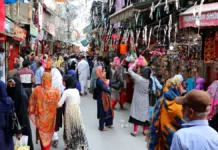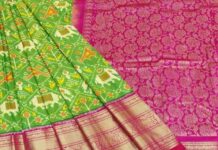 The Buddha stands headless. His toes broken. The necklace dented. His drapes frayed. His hands are missing but the contours of his torso still seamless.
The Buddha stands headless. His toes broken. The necklace dented. His drapes frayed. His hands are missing but the contours of his torso still seamless.
The Buddha stands not in a cave but in Sacramento’s (California) Crocker Art Museum, the longest continuously-run art museum in the West. This small scale image dating back to 4th to early 5th century was discovered in Madhya Pradesh (Central India) and is now on display at the Museum’s Asian Art Collection. A note by the sculpture details that this Gupta period (350-520) art and its distinguishing treatment of robe and visible belt suggest that it was commissioned by a follower of the Sarvastivada sect.
He, however, is not alone in the Crocker’s Asian Collection. There’s a stone Skanda, the Hindu God of War, who is being blessed by a three-headed Brahma. Belonging to 7-8th century, this northwest India artifact was probably installed as part of an enclosed walkway encircling a Hindu temple.
In another room, a marble Jain temple door frame stands against a red backdrop. On another wall i s nailed a 9th-10th century buff stone door jamb. From early 5th century, the doorway has been a focal point of Hindu temples and this door jamb follows the tradition of depicting river goddesses Ganga and Yamuna. Behind a thick glass pane sits a sandstone Ganesha (12-13th century, Central India), a buff sandstone Nagini (10-11th century, Central India) and a sandstone Maitreya (2nd century, Mathura).
s nailed a 9th-10th century buff stone door jamb. From early 5th century, the doorway has been a focal point of Hindu temples and this door jamb follows the tradition of depicting river goddesses Ganga and Yamuna. Behind a thick glass pane sits a sandstone Ganesha (12-13th century, Central India), a buff sandstone Nagini (10-11th century, Central India) and a sandstone Maitreya (2nd century, Mathura).
 Says Amelia Kit-Yiu Chau, Adjunct Curator of Asian Art, Crocker Art Museum, “In the last 25 years, the Crocker Art Museum has seen a very strong growth in its permanent collection of Indian art. Thanks to the generous donations of paintings, sculptures, and textiles by the collectors William and Edith Cleary, Anne and Malcolm McHenry, Phyllis Oja Jones, and Pramila and Indru Kriplani, the Crocker Art Museum has presented its visitors with a great range of Indian art that date from as early as the 2nd century, to the 20th century. The Crocker remains committed to expanding its holdings in Indian art, as well as hosting exhibitions of the arts of India in the future.”
Says Amelia Kit-Yiu Chau, Adjunct Curator of Asian Art, Crocker Art Museum, “In the last 25 years, the Crocker Art Museum has seen a very strong growth in its permanent collection of Indian art. Thanks to the generous donations of paintings, sculptures, and textiles by the collectors William and Edith Cleary, Anne and Malcolm McHenry, Phyllis Oja Jones, and Pramila and Indru Kriplani, the Crocker Art Museum has presented its visitors with a great range of Indian art that date from as early as the 2nd century, to the 20th century. The Crocker remains committed to expanding its holdings in Indian art, as well as hosting exhibitions of the arts of India in the future.”
Established in 1885, Crocker Art Museum has a rich collection of Californian art, works on paper, European art, international ceramics, photography, Asian art, and African and Oceanic art. It is the only museum in the Sacramento region accredited by the American Alliance of Museums (AAM), a recognition given to less than 1,100 of the nation’s 33,000 museums.
Preeti Verma Lal






